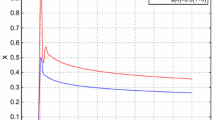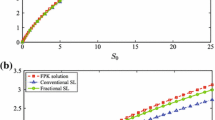Abstract
Considered are systems of single-mass oscillators with different fractional damping behaviour. Similar to the classical model, where the damping terms are represented by first derivatives, the eigensystem can be used to decompose the fractional system in frequency domain, if mass, stiffness and damping matrices are linearly dependent. The solution appears as a linear combination of single-mass oscillators. This is true even in the general case such that stability and causality are insured by the same argumentation as used in the linear dependent case.
Similar content being viewed by others
References
Kempfle, S., Schäfer, I., and Beyer, H., ‘Fractional calculus via functional calculus: Theory and applications’, Nonlinear Dynamics29, 2002, 99–127.
Kempfle, S. and Beyer, H., ‘The scope of a functional calculus approach to fractional differential equations’, in Progress in Analysis (Proceedings of ISAAC’01), World Scientific, Singapore, 2003, pp. 69–81.
Stein, E. M. and Weiss, G., Introduction to Fourier Analysis on Euclidean Spaces, University Press, Princeton, New Jersey, 1971.
Walter, W., Einführung in die Theorie der Distributionen. 3. Aufl. Bibliographisches Institut Mannheim, Germany, 1994.
Gel’fand, I. M. and Shilov, G. E., Generalized Functions, Vol. 1. Academic Press, New York, 1964.
Grubb, G., ‘Pseudodifferential boundary problems and applications’, Deutsche Mathematiker Vereinigung, Jahresbericht99(3), 1997, 110–121.
Kempfle, S. and Schäfer, I., ‘Fractional differential equations and initial conditions’, Fractional Calculus & Applied Analysis3(4), 2000, 387–400.
Beyer, H. and Kempfle, S., ‘Definition of physically consistent damping laws with fractional derivatives’, Zentralblatt für angewandte Mathematik und Mechanik75(8), 1995, 623–635.
Kempfle, S. and Beyer, H., ‘Global and causalsolutions of fractional differential equations’, in Proceedings of the 21st International Workshop on Transform Methods & Special Functions, Varna’96,IMI-BAS, Sofia, Bulgaria, P. Rusev, I. Dimovski, and V. Kiryakowa (eds.), 1998, pp. 210–226.
Bathe, K. J. and Wilson, E., Numerical Methods in Finite Element Analysis, Prentice Hall, New Jersey, 1976.
Schmidt, N., ‘Impulsantworten von fraktional gedämpften Zwei- und Dreimassenschwingern’, Studienarbeit, UniBwH, Hamburg, Germany, 2003 [in German].
Conway, J. B., Functions of One Complex Variable, Springer-Verlag, New York, 1978.
Henrici, P., Applied and Computational Complex Analysis, Vol. 1, Wiley, New York, 1974.
Author information
Authors and Affiliations
Corresponding author
Rights and permissions
About this article
Cite this article
Schäfer, I., Kempfle, S. Impulse Responses of Fractional Damped Systems. Nonlinear Dyn 38, 61–68 (2004). https://doi.org/10.1007/s11071-004-3746-8
Received:
Accepted:
Issue Date:
DOI: https://doi.org/10.1007/s11071-004-3746-8




